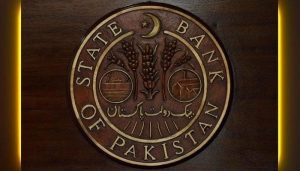The policy rate was raised by SBP by 100 basis points to 22%.
Since their last meeting on June 12th, the MPC has noticed a rise in the likelihood of upside risks to the inflation forecast.

In an emergency meeting held on Monday, Pakistan’s central bank increased its key policy rate by 100 basis points, setting a new record high of 22%, in order to satisfy another demand of the International Monetary Fund (IMF) in order to resume its lending programme.
The new fee would go into force as of today, June 27.
Since the resumption of all imports as of last Friday (June 23), the bank has predicted that the rupee may lose value versus the US currency.
In its most recent monetary policy statement (MOS), the State Bank of Pakistan (SBP) stated that an increase in its benchmark policy rate was necessary because inflation was expected to rise in the future.
Prior to May 2023, the country’s inflation rate had reached a six-decade high of 38%. Inflation data for June would be released early in the month of July.
After leaving it steady at its previous meeting on June 12, the bank has now raised its policy rate to 22%.
Inflation statistics for May was in line with its projections, and the bank has previously stated that the current rate of 21 percent is adequate for this purpose.
The bank expected the reading to rise in May and then decline in June and beyond.
Private sector borrowing from banks to operate enterprises has been severely discouraged by the historically high policy rate.
In the previous fiscal year (2023), economic activity dropped to 0.3% from 6.1% growth in FY22 due to the high interest rate.
The central bank announced the rate hike via Twitter, writing, “MPC (monetary policy committee) of SBP convened an emergency meeting today (Monday), where it noted that potential upside risks to the inflation outlook have increased since the last meeting (June 12, 2023) and accordingly decided to raise the policy rate by 100 basis points to 22%.”
According to MPC, these concerns stem largely from the introduction of additional fiscal and external measures, which are crucial in the context of the conclusion of the current IMF programme.
To help drive inflation down to the medium-term target of 5% to 7% by the end of the fiscal year 2025, the central bank emphasised that today’s (Monday) decision is important to keep the real interest rate firmly in positive territory on a forward-looking basis.
The MPC said in its statement following its June 12 meeting that the current monetary policy stance was suitable “barring any unexpected domestic and external shocks” in order to accomplish the goal of price stability.
The MPC also said that “effective addressing the prevailing domestic uncertainty and external vulnerabilities” was necessary for this forecast to materialise.
However, two significant internal developments have occurred since the committee’s last meeting, which have slightly worsened the inflation forecast and which may put additional strain on the already strained external account.
To begin, the rates of certain taxes and tariffs, as well as the Petroleum Development Levy (PDL), were raised in the final version of the FY24 budget that was passed by Congress on June 25.
On June 23, the SBP rescinded its broad recommendation for commercial banks regarding the prioritising of imports, thereby reopening all imports immediately.
According to the SBP’s monetary policy statement, “while the MPC views these measures as necessary in the context of the completion of the ongoing IMF programme,” they have increased the upside risks to the inflation outlook.
Find out why the PSX rose on higher IMF hopes in the linked article.
The Monetary Policy Committee (MPC) of the central bank believes that “additional tax measures are likely to contribute to inflation both directly and indirectly,” while the easing of restrictions on imports may place pressures on the foreign exchange market. The latter could cause a greater than expected increase in domestic prices as a result of the pass-through of the exchange rate.
In the first trading session following the resumption of imports, the rupee’s value increased by 0.01 percent, or Rs0.03, to Rs286.71 versus the United States dollar on the interbank market.
Before its official expiration on June 30, 2023, the administration is working to resuscitate the IMF plan.
It has already implemented IMF-recommended changes to its local currency markets, imports, and budget for 2024.
One of the three primary conditions of the IMF to renew its programme is for it to obtain gap financing of $6 billion from friendly countries.
With the completion of the current IMF programme and the government maintaining its commitment to producing a primary surplus in FY24, the MPC believes that the decision made on Monday will assist resolve external sector risks and decrease economic uncertainty.
The committee reaffirmed that it would keep a close eye on the economy and would be prepared to act as needed to maintain price stability in the medium term.









































